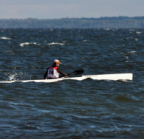- Posts: 78
- Thank you received: 25
A surfski safety device of last resort
- Henning DK
- Offline
- Senior Member
manta wrote: If you cannot rescue yourself and you will not be able to get rescuers to you, should you be out there?
That's the question! But there is no answer, it's a choice
Please Log in or Create an account to join the conversation.
Massive waves, laden boat, his boat got broken in two.
After a long night at sea, he made it ashore.
Walked out, made it to a road and flagged down a motorist (I don't know how long it took, think it was a couple of days).
What saved him was being extremely fit, not giving up, survival knowledge and knowing his location. When he reached the shore, he knew which direction to head; had he turned the wrong way, he probably wouldn't have made it. He also knew how to scavenge, find water etc.
His gear was lost at sea.
Please Log in or Create an account to join the conversation.
Might want to get real familiar with your communication device in real conditions if you haven't already.
Please Log in or Create an account to join the conversation.
- SpaceSputnik
- Offline
- Platinum Member
- Posts: 524
- Thank you received: 42
Fath2o wrote: I'm curious how many here have tried communicating with their vhf handheld radios while treading water, or in rough wet conditions while sitting in your ski (which might be a challenge). My experience was radio was wet or had been submerged the speaker was completely unreadable. I had no problem transmitting but couldn't understand the incoming audio. I also need reading glasses to see the tiny screen. Don't often have a pair when paddling.
Might want to get real familiar with your communication device in real conditions if you haven't already.
Yes, it happens to me after a remount practise, the volume goes quite low. Sucking the water out of the speaker grill may help. But, I am with you, it may be a problem. That's why I am glad my radio is DSC enabled, so I can press the distress button even if I can't talk.
Never been in need of a rescue though....a skittish flatwater paddler
Please Log in or Create an account to join the conversation.
What's a good position to put my arm in to simulate a dislocation? just limp to my side? What's doable/not doable with a dislocation?
Please Log in or Create an account to join the conversation.
Please Log in or Create an account to join the conversation.
- SurfskiEstonia
-
 Topic Author
Topic Author
- Offline
- Premium Member
- Posts: 122
- Thank you received: 15
HUGE thanks to TomVW!!! This was exactly what I was searching for. I'm gonna definitely buy some and try to use them in a pair, as You suggested. Wonder how to fix it to the carbon/kevlar structure of the boat, but will figure out.
As for all the other arguments regarding being a true fighter with a fit body and a cool head, unfortunately I'm not like that:D I'm afraid that in a really bad situation I may be prone to giving up, so having a safety plan like that is a must for me.
Generally, there are 5 scenarios I see as risks while far from shore:
1. A serious injury (shoulder/ wrist injury, long-lasting cramp, stroke);
2. Not being able to remount because of cold and/or fatigue;
3. Losing the ski after a capsize;
4. Having the ski damaged so badly that it to sinks;
5. Being hit by a jet ski / speed boat or some other water hooligans.
Numbers 3-5 don't apply to our topic of discussion, but the 1-2 are exactly the ones where such a clamp arrangement could at least give hope if not save the paddler. It's very painful to imagine such situations, but I wonder if those paddlers who died on water because the inability to remount, could have used such a solution to save their life. Imagine if such clamps (if they work on fast skis) were installed on all surfskis by manufacturers with a bungee cord holding down two floatation bags. It would add about 300-500g of weight to the ski, but in case of a really bad situation it really could make a difference, or at least give hope.
If anyone has got other good ideas, please share:)
Current: Carbonology Boost double, Jantex Gamma Mid
Previous: Nelo Ocean Ski L, Jantex Gamma Rio Large Minus
Please Log in or Create an account to join the conversation.
Please Log in or Create an account to join the conversation.
- Spacehopper
-

- Offline
- Premium Member
- Posts: 121
- Thank you received: 31
To add another thought about the limits of VHFs that Fath raises - worth also remembering that VHF works on line of sight, pretty much independent of what 'wattage' it is. So what probably works great on a Millers Run - high coastline near a major city, where I would guess there are aerials up high - may not work if you paddle somewhere more out-of-the-way, with a low coastline/little boat traffic. Probably best not to put too much faith in a VHF in that case. If you are in the water then your effective aerial height is maybe 12-18inches - and if the swell is 6ft you might to struggle to get any message out...
Please Log in or Create an account to join the conversation.
Latest Forum Topics
-
- Getting back into training routine
- 4 hours 44 minutes ago
-
- Marine VHF Radio
- 1 day 23 hours ago
-
- Best way to carry a marine radio?
- 2 days 34 minutes ago
-
- Straightening a twisted carbon skeg/rudder
- 2 days 23 hours ago

